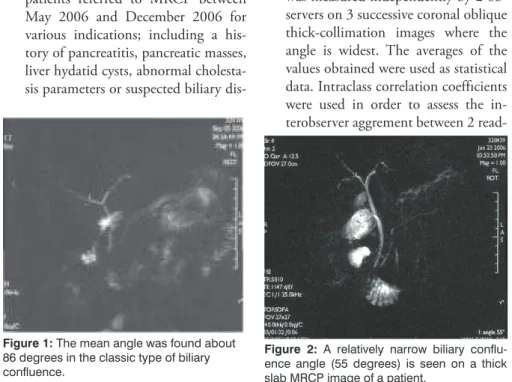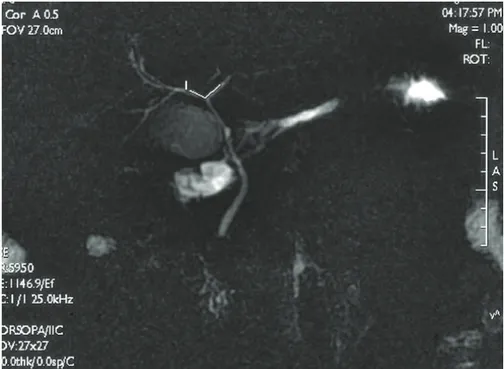163
Ankara Üniversitesi Tıp Fakültesi Mecmuası 2009, 62(4) DAHİLİ BİLİMLER / MEDICAL SCIENCES
Araştırma Makalesi / Research Article
Başvuru tarihi: 01.11.2010 • Kabul tarihi: 25.06.2010 İletişim
Uz.Dr.Nuray Haliloğlu
Ankara Üniversitesi Tıp Fakültesi Radyodiagnostik Anabilim Dalı Tel : 0 312 595 63 71
E-Posta Adresi : nurayunsal2@hotmail.com
MR kolanjiopankreatografi (MRKP) görüntüleri üzerinden ortalama biliyer konfluens açısını hesap-layarak bu açı ile yaş, cins ve vücut kitle indeksi arasındaki olası ilişkiyi araştırmak amaçlanmıştır.
Gereç ve Yöntem: Mayıs 2006 ile Aralık 2006 tarihleri arasında karaciğer fonksiyon testlerinde
bo-zukluk ya da safra kanallarında patoloji şüphesi başta olmak üzere çeşitli endikasyonlarla MRKP yapılan toplam 40 hasta (18 kadın, 22 erkek, yaş aralığı 22-86 yaş) çalışmaya dahil edildi. Hastala-rın hiçbirinde geçirilmiş karaciğer ameliyatı öyküsü ve biliyer konfluens düzeyinde yer kaplayan lezyon yoktu. Safra kanalı varyasyonu olanlar ve bilinen safra yolu ya da kronik karaciğer parankim hastalığı tanısı olanlar çalışma dışı bırakıldı. Biliyer konfluens açısı iki radyolog tarafından koronal oblik planda alınan üç ardışık kalın kesit MRKP görüntüsü üzerinden ve açının en geniş olduğu dü-zeylerden ayrı ayrı ölçülerek her araştırmacı için ortalama değerler kaydedildi.
Sonuçlar: İstatistiksel olarak iki araştırmacı arasında yüksek uyum mevcuttu (p<0.001, intraclass
correlation coefficient= 0.93). Birinci araştırmacı için hesaplanan ortalama açı 87.87± 22.92° (aralık 51-155°) iken ikinci araştırmacı için ortalama açı 85.40± 25.80° (aralık 45-166°) idi. Biliyer konfluens açısı ile yaş, cins ya da vücut kitle indeksi arasında istatistiksel olarak anlamlı bir ilişki bulunmadı. Birinci araştırmacı için ortalama açının %95 güven aralığı üst ve alt sınırları 80.54-95.20° iken, ikin-ci araştırmacı için 77.14-93.65° idi.
Sonuç: İstatistiksel olarak normal biliyer konfluens açısının yaş, cins ve vücut kitle indeksinden
ba-ğımsız olduğu ortaya konmuştur.
Anahtar Sözcükler: Safra Yolları, Kolanjiyopankreatografi, Safra Kanalları
We aimed to determine the mean biliary confluence angle on MR cholangiopancreatography (MRCP) images and investigated the variability of the angle by age, gender, and body mass index.
Material and Methods: The study population was drawn from the patients referred to MRCP between
May 2006 and December 2006 for various indications; the most being for abnormal liver function tests or suspected biliary disease. A total of 40 patients (18 women and 22 men, age range 22-86 years) who denied a history of prior liver surgery, and in whom MRCP excluded bile duct variations, biliary diseases or chronic parenchymal liver disease were enrolled. The confluence angle was measured independently by 2 observers on 3 successive coronal oblique thick-collimation images where the angle is widest and the mean values were noted for each observer.
Results: Statistically there was almost perfect agreement between 2 observers (p<0.001,
intraclass correlation coeffıcient= 0.93). The mean value was 87.87± 22.92 degrees for the lst observer (range 51-155 degrees) and 85.40± 25.80 degrees for the 2nd observer (range 45-166 degrees). No statistically significant correlation was found between biliary confluence angle and age, gender or body mass index. The lower and upper bounds of 95% confîdence interval for mean were 80.54-95.20 degrees for the lst observer and 77.14-93.65 degrees for the 2nd observer.
Conclusion: Normal biliary confluence angle is independent of age, gender, and body mass index.
Key Words : Biliary Tract, Cholangiopancreatography, Bile Ducts
Ankara Üniversitesi Tıp Fakültesi Radyodiagnostik Anabilim Dalı
Normal Biliary Confluence Angle In Classical Junction Type:
Assessment With MR Cholangiopancreatography
Normal Biliyer Konfluens Açısının MR Kolanjiopankreatografi ile Değerlendirilmesi
Nuray Haliloğlu, Ayşe Erden, İlhan Erden
Intrahepatic bile ducts form two large trunks -right and left hepatic duct- which leave the liver at the transverse fissure. The union of these trunks is the common hepatic duct and the bili-ary confluence angle is the angle
be-tween the right and left hepatic ducts. The classic biliary junction which is seen in 53%-72% of normal subjects, is formed outside the liver parenchy-ma, just before the common biliary duct arises (1,2).
164 Normal Biliary Confluence Angle In Classical Junction Type: Assessment With MR Cholangiopancreatography
Ankara Üniversitesi Tıp Fakültesi Mecmuası 2009, 62(4) The confluence angle is not measured
dur-ing the routine MR cholangiopancrea-tography (MRCP) readings. However widening of the angle may be relevant when a mass is located in this area. In patients with intrahepatic bile duct diseases like primary sclerosing chol-angitis careful attention is paid to the bile duct confıguration in order not to miss signs of an early disease. In some of these patients we observed that the width of the biliary conflunce angle was wide but hence no normal values were described for this angle we could not produce any quantitative results. When we started to monitor the con-fluence angle particularly, we observed that the width of the confluence angle varied individually. Before going any further we wanted to determine if there would be demographic factors contributing to the width of the bili-ary confluence.
The aim of this study is to evaluate the mean biliary confluence angle on MRCP images and to determine whether there is a relation between the angle and age, gender, and body mass index of the subjects.
Materials and Methods
The study population was drawn from the patients referred to MRCP between May 2006 and December 2006 for various indications; including a his-tory of pancreatitis, pancreatic masses, liver hydatid cysts, abnormal cholesta-sis parameters or suspected biliary
dis-ease. A total of 40 patients who denied a history of prior liver surgery, and in whom MRCP excluded bile duct variations, biliary diseases or chronic parenchymal liver disease were en-rolled. There were 18 women and 22 men aged 22-86 years (mean age 51 years). MRCP was performed on a 1.0 Tesla MR system (Signa LX Horizon; General Electric Medical Systems, Milwaukee, WI) using phased array coil and 2 dimensional single-shot-fast spin-echo (SSFSE) sequence. All scans were performed by the same radiol-ogy technician. A 5- mm thick con-tiguous multisection acquisition was performed in the axial plane through the upper abdomen and the common bile duct was localized in the axial plane. The thick slabs (40 mm) in the oblique coronal plane were obtained centering the common bile duct. The breath-hold period was 2 sec for each slab. The imaging parameters of the thick slabs could change individually for each patient but they could be ob-tained as; TR: 1700-15.000 msec, TE: 900-110 msec, bandwidth: 25-31.2 kHz, field of view: 35-40 cm, matrix size: 256x256 pixels, number of excita-tions: 0.5-1.
The MRCP images were analyzed at the workstation and the confluence angle was measured independently by 2 ob-servers on 3 successive coronal oblique thick-collimation images where the angle is widest. The averages of the values obtained were used as statistical data. Intraclass correlation coeffıcients were used in order to assess the in-terobserver aggrement between 2
read-ers. Mann-Whitney U test was used to analyze the correlation between the biliary confluence angle and the age, gender, and body mass index of the patients.
Results
Coronal oblique thick-collimation im-ages were adequate to measure the biliary confluence angle in all patients. When comparing the measurements of the two observers we ensured that the most frequently measured images on which the biliary confluence angle was widest were the third, fourth, and fifth images. This was probably be-cause the same technician performed all scans. The average body mass in-dex was 26.8 kg/m(2) (range 17.9-42.2 kg/m(2)). Statistically there was almost perfect agreement between 2 observers (p<0.001, intraclass corre-lation coefficient= 0.93). The mean value was 87.87± 22.92 degrees for the lst observer (range 51-155 degrees) and 85.40± 25.80 degrees for the 2nd observer (range 45-166 degrees) (Fig-ures 1-3). No statistically significant correlation was found between biliary confluence angle and age, gender or body mass index (p>0.05). The lower and upper bounds of 95% confidence interval for mean were 80.54-95.20 degrees for the lst observer and 77.14-93.65 degrees for the 2nd observer.
Discussion
Intrahepatic bile ducts course with the portal vein branches. During the em-bryological development, the divisions of the portal vein appear before the de-velopment of the hepatic ducts hence the bile ducts follow the course of the portal vein divisions (3,4).
MRCP is widely used as the initial imaging method to evaluate the pancreatobili-ary pathologies and it has a high diag-nostic accuracy (5,6). In patients with suspicion of biliary diseases, MRCP is a good non-invasive alternative to en-doscopic retrograde cholangiopancrea-tography (ERCP) and when
interpret-Figure 1: The mean angle was found about
86 degrees in the classic type of biliary confluence.
Figure 2: A relatively narrow biliary
conflu-ence angle (55 degrees) is seen on a thick slab MRCP image of a patient.
165
Nuray Haliloğlu, Ayşe Erden, İlhan Erden
Journal Of Ankara University Faculty of Medicine 2009, 62(4)
ing MRCP images the course of the bile ducts can be a clue for a hepatic parenchymal changes which may cause dislocation or distortion of the ducts. The anatomy of the intrahepatic bile ducts,
especially the branching pattems at the
biliary confluence are widely discussed in the literature because of the surgical importance of this area in liver trans-plantation (7-10). Nevertheless there has been no study describing the vari-ability of the biliary confluence angle width.
In our study of 40 adults, the mean angle of the biliary confluence was about 86 degrees. The values for the biliary con-fluence angle ranged widely in normal subjects. Also age, gender and body mass index did not appear to have an effect on the confluence angle. Perceptional differences in the image evaluation and angle measurement were unlikely with this technique. The intraclass correlation coefficient for the two readers showed almost perfect agreement.
The width of hilar confluence angle may provide a clue about the presence of hilar masses, parenchymal atrophy of the liver and periportal space lesions if there is an alteration in the angle on consecutive MRCP studies. However, we believe that measuring this angle is of limited use as a practical criterion of such diseases on routine MRCP readings because of the wide range of normal values. Severe de-viations from normal limits, especially in follow-up patients, may arise suspicion of abnormality, and may warrant addi-tional investigation for hilar hepatobili-ary lesion on conventional Tl- and T2-weighted MR images.
REFERENCES
1) Kawarada Y, Das BC, Taoka H. 2000. Anato-my of the hepatic hilar area: the plate system. J Hepatobiliary Pancreat Surg 7:580-586. 2) Castaing D. Surgical anatomy of the biliary
tract 2008. HPB 10:72-76.
3) Couinaud C. 1999. Liver anatomy: portal (and suprahepatic) or biliary segmentation. Dig Surg 16:459-467.
4) Kitami M, Takase K, Murakami G, Ko S, Tsuboi M, Saito H, Higano S, Nakajima Y, Takahashi S. 2006. Types and frequencies of biliary tract variations associated with a major portal venous anomaly: analysis with multi-detector row CT cholangiography. Radiology 238:156-166.
5) Hekimoglu K, Ustundag Y, DusakA, et al. MRCP vs ERCP in the evaluation of biliary pathologies: review of the current literature. J Dig Dis. 2008;9:162-169.
6) Weber C, Kuhlencordt R, Grotelueschen R, et al. Magnetic resonance cholangio-pancreatography inthe diagnosis of pri-mary sclerosing cholangitis. Endoscopy 2008; 40: 739-745.
7) Cheng YF, Huang TL, Chen CL, Chen YS, Lee TY. 1997. Variations of the intrahepatic bile ducts: application in living related liver transplantation and splitting liver transplan-tation. Clin Transplant 11:337-340. 8) Ohkubo M, Nagino M, Kamiya J, Yuasa N,
Oda K, Arai T, Nishio H, Nimura Y. 2004. Surgical anatomy of the bile ducts at the he-patic hilum as applied to living donor liver transplantation. Ann Surg 239: 82-86.
9) Choi JW, Kim TK, Kim KW, Kim AY, Kim PN, Ha HK, Lee MG. 2003. Anatomic variation in intrahepatic bile ducts: an analysis of intra-operative cholangiograms in 300 consecutive donors for living donor liver transplantation. Korean J Radiol 4:85-90.
10) Lee VS, Krinsky GA, Nazzaro CA, Chang JS, Babb JS, Lin JC, Morgan GR, Teperman LW. 2004. Defining intrahepatic biliary anatomy in living liver transplant donor candidates at Mangafodipir Trisodium- enhanced MR cholangiography versus conventional T2- weighted MR cholangiography. Radiology 233:659-666.

